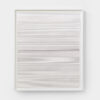My trip to Paris last week was filled with artistic highlights. Coinciding with Paris+ Art Basel, the Fondation Louis Vuitton opened an extraordinary retrospective of Mark Rothko, one of the most important artists of the 20th century, on Wednesday, 18.10.23. With 115 works on 4 floors from various international collections, this show is the most comprehensive Mark Rothko exhibition worldwide. It spans from Rothko’s early work to his abstract color field paintings, which brought him worldwide fame.
I must admit that I have never seen a painting by Rothko in real life, so it was a very special visit for me. I have been admiring his works for some time, but always through the screen or in books. And I have heard many stories about the first encounter with his paintings – my expectations were accordingly high. Straight off the bat: There was no emotional outburst, but what did come was an unprecedented fascination.
The opening day was rainy, but we were lucky. The heavy rain didn’t start until after we entered the Fondation, designed by American architect Frank Gehry. The entrance hall was packed with people seeking shelter from the rain. After a quick search, we went straight to the first gallery. The exhibition opens with Rothko’s only self-portrait from 1936 from the collection of his son Christopher, co-curator of the show. Paintings from his early days in the 1930s and 1940s followed. Already almost unremarkable, they deal with intimate scenes and urban landscapes. Later he switched to a style inspired by ancient myths and surrealism.
In the following galleries, Rothko’s powerful aura and distinctive aesthetics are recognizable for the first time in his Multiforms and early classic works. Wide bands of color in various tones seem to float on the canvases. These early abstract works seem quite restless and uncoordinated at first but evolve into calmer and more minimalist compositions toward the end of the 1940s.
Especially in Gallery 4, where works from the 1950s onward are on display, his paintings become more powerful and captivating. Some of them are so large that they fill my entire field of vision as if I were inside them. Others seem like a window into another world that you want to explore. The longer you look at a painting up close, the more the surface seems to change. Brushstrokes, underlying layers of color, shiny areas, and even alleged “flaws” come to light, suddenly turning the homogeneous surface into something alive. I have the feeling of being alone with the work, even though on the opening day hundreds of other visitors are walking around me.


The muted light creates an atmosphere that highlights the glow and these special characteristics of the paintings. The galleries are equipped with benches that are positioned so that one can take the time to view them from a distance while sitting. In Gallery 5, I would like to highlight the Seagram Murals (see image above). These large-format works are almost exclusively in dark shades of red, brown, and black. Nowadays, you can only see them at the Tate Modern in London. These works resulted from a commission Rothko received in 1958 for the restaurant in the Seagram Building, designed by Mies van der Rohe. However, Rothko withdrew from the commission because he did not want his art presented in such a commercial setting. The murals were later distributed to art galleries worldwide.
A personal highlight for me was the incredibly aesthetic Gallery 10, dedicated to the artist’s late work (1969 – 1970). This room, this time more brightly lit than the others, features two sculptures by Alberto Giacometti in an impressive interplay with Rothko’s works. These dark, monochrome works, were often misunderstood in the past. The public long assumed that his choice of color was a reflection of Rothko’s depressed state of mind. On the one hand, these thoughts are understandable, especially now that one has seen many of his previous, luminous works. These paintings, however, are sober, austere, and quite different from what one has seen of Rothko before. However, a more contemporary reading, supported by many artists, proposes a different interpretation that links them more to Minimalism.
The powerful and captivating aesthetics of his work, combined with the extraordinary architecture and the sculptures of Alberto Giacometti, make this exhibition an unforgettable experience. I can therefore only recommend to all art enthusiasts not to miss this exhibition. It is a tribute to Rothko’s life and work and an impressive demonstration of his ability to establish an emotional exchange with the viewer. Rothko creates a meditative moment that, despite the many people around you, gives you the feeling of tranquility and timelessness.
The exhibition will be on display until April 2, 2024. See more information here.


